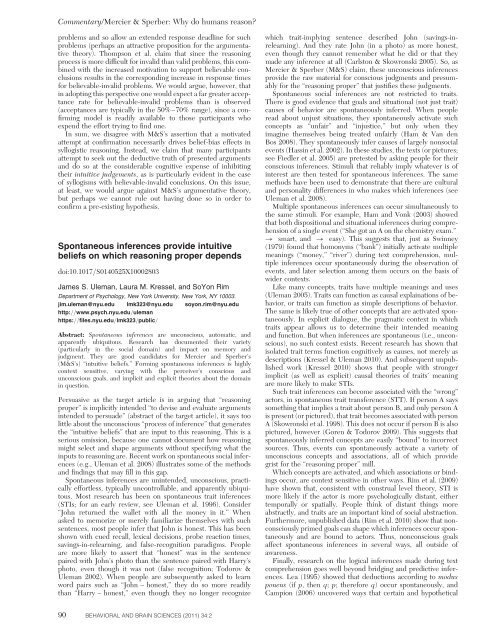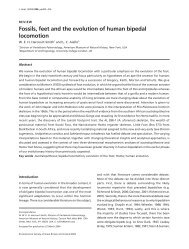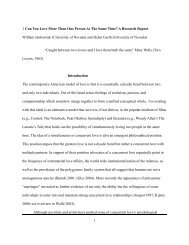Why do humans reason? Arguments for an argumentative theory
Why do humans reason? Arguments for an argumentative theory
Why do humans reason? Arguments for an argumentative theory
You also want an ePaper? Increase the reach of your titles
YUMPU automatically turns print PDFs into web optimized ePapers that Google loves.
Commentary/Mercier & Sperber: <strong>Why</strong> <strong>do</strong> <strong>hum<strong>an</strong>s</strong> <strong>reason</strong>?problems <strong>an</strong>d so allow <strong>an</strong> extended response deadline <strong>for</strong> suchproblems (perhaps <strong>an</strong> attractive proposition <strong>for</strong> the <strong>argumentative</strong><strong>theory</strong>). Thompson et al. claim that since the <strong>reason</strong>ingprocess is more difficult <strong>for</strong> invalid th<strong>an</strong> valid problems, this combinedwith the increased motivation to support believable conclusionsresults in the corresponding increase in response times<strong>for</strong> believable-invalid problems. We would argue, however, thatin a<strong>do</strong>pting this perspective one would expect a far greater accept<strong>an</strong>cerate <strong>for</strong> believable-invalid problems th<strong>an</strong> is observed(accept<strong>an</strong>ces are typically in the 50%–70% r<strong>an</strong>ge), since a confirmingmodel is readily available to those particip<strong>an</strong>ts whoexpend the ef<strong>for</strong>t trying to find one.In sum, we disagree with M&S’s assertion that a motivatedattempt at confirmation necessarily drives belief-bias effects insyllogistic <strong>reason</strong>ing. Instead, we claim that m<strong>an</strong>y particip<strong>an</strong>tsattempt to seek out the deductive truth of presented arguments<strong>an</strong>d <strong>do</strong> so at the considerable cognitive expense of inhibitingtheir intuitive judgements, as is particularly evident in the caseof syllogisms with believable-invalid conclusions. On this issue,at least, we would argue against M&S’s <strong>argumentative</strong> <strong>theory</strong>,but perhaps we c<strong>an</strong>not rule out having <strong>do</strong>ne so in order toconfirm a pre-existing hypothesis.Spont<strong>an</strong>eous inferences provide intuitivebeliefs on which <strong>reason</strong>ing proper depends<strong>do</strong>i:10.1017/S0140525X10002803James S. Ulem<strong>an</strong>, Laura M. Kressel, <strong>an</strong>d SoYon RimDepartment of Psychology, New York University, New York, NY 10003.jim.ulem<strong>an</strong>@nyu.edu lmk323@nyu.edu soyon.rim@nyu.eduhttp://www.psych.nyu.edu/ulem<strong>an</strong>https://files.nyu.edu/lmk323/public/Abstract: Spont<strong>an</strong>eous inferences are unconscious, automatic, <strong>an</strong>dapparently ubiquitous. Research has <strong>do</strong>cumented their variety(particularly in the social <strong>do</strong>main) <strong>an</strong>d impact on memory <strong>an</strong>djudgment. They are good c<strong>an</strong>didates <strong>for</strong> Mercier <strong>an</strong>d Sperber’s(M&S’s) “intuitive beliefs.” Forming spont<strong>an</strong>eous inferences is highlycontext sensitive, varying with the perceiver’s conscious <strong>an</strong>dunconscious goals, <strong>an</strong>d implicit <strong>an</strong>d explicit theories about the <strong>do</strong>mainin question.Persuasive as the target article is in arguing that “<strong>reason</strong>ingproper” is implicitly intended “to devise <strong>an</strong>d evaluate argumentsintended to persuade” (abstract of the target article), it says toolittle about the unconscious “process of inference” that generatesthe “intuitive beliefs” that are input to this <strong>reason</strong>ing. This is aserious omission, because one c<strong>an</strong>not <strong>do</strong>cument how <strong>reason</strong>ingmight select <strong>an</strong>d shape arguments without specifying what theinputs to <strong>reason</strong>ing are. Recent work on spont<strong>an</strong>eous social inferences(e.g., Ulem<strong>an</strong> et al. 2008) illustrates some of the methods<strong>an</strong>d findings that may fill in this gap.Spont<strong>an</strong>eous inferences are unintended, unconscious, practicallyef<strong>for</strong>tless, typically uncontrollable, <strong>an</strong>d apparently ubiquitous.Most research has been on spont<strong>an</strong>eous trait inferences(STIs; <strong>for</strong> <strong>an</strong> early review, see Ulem<strong>an</strong> et al. 1996). Consider“John returned the wallet with all the money in it.” Whenasked to memorize or merely familiarize themselves with suchsentences, most people infer that John is honest. This has beenshown with cued recall, lexical decisions, probe reaction times,savings-in-relearning, <strong>an</strong>d false-recognition paradigms. Peopleare more likely to assert that “honest” was in the sentencepaired with John’s photo th<strong>an</strong> the sentence paired with Harry’sphoto, even though it was not (false recognition; To<strong>do</strong>rov &Ulem<strong>an</strong> 2002). When people are subsequently asked to learnword pairs such as “John – honest,” they <strong>do</strong> so more readilyth<strong>an</strong> “Harry – honest,” even though they no longer recognizewhich trait-implying sentence described John (savings-inrelearning).And they rate John (in a photo) as more honest,even though they c<strong>an</strong>not remember what he did or that theymade <strong>an</strong>y inference at all (Carlston & Skowronski 2005). So, asMercier & Sperber (M&S) claim, these unconscious inferencesprovide the raw material <strong>for</strong> conscious judgments <strong>an</strong>d presumably<strong>for</strong> the “<strong>reason</strong>ing proper” that justifies these judgments.Spont<strong>an</strong>eous social inferences are not restricted to traits.There is good evidence that goals <strong>an</strong>d situational (not just trait)causes of behavior are spont<strong>an</strong>eously inferred. When peopleread about unjust situations, they spont<strong>an</strong>eously activate suchconcepts as “unfair” <strong>an</strong>d “injustice,” but only when theyimagine themselves being treated unfairly (Ham & V<strong>an</strong> denBos 2008). They spont<strong>an</strong>eously infer causes of largely nonsocialevents (Hassin et al. 2002). In these studies, the texts (or pictures;see Fiedler et al. 2005) are pretested by asking people <strong>for</strong> theirconscious inferences. Stimuli that reliably imply whatever is ofinterest are then tested <strong>for</strong> spont<strong>an</strong>eous inferences. The samemethods have been used to demonstrate that there are cultural<strong>an</strong>d personality differences in who makes which inferences (seeUlem<strong>an</strong> et al. 2008).Multiple spont<strong>an</strong>eous inferences c<strong>an</strong> occur simult<strong>an</strong>eously tothe same stimuli. For example, Ham <strong>an</strong>d Vonk (2003) showedthat both dispositional <strong>an</strong>d situational inferences during comprehensionof a single event (“She got <strong>an</strong> A on the chemistry exam.”! smart, <strong>an</strong>d ! easy). This suggests that, just as Swinney(1979) found that homonyms (“b<strong>an</strong>k”) initially activate multipleme<strong>an</strong>ings (“money,” “river”) during text comprehension, multipleinferences occur spont<strong>an</strong>eously during the observation ofevents, <strong>an</strong>d later selection among them occurs on the basis ofwider contexts.Like m<strong>an</strong>y concepts, traits have multiple me<strong>an</strong>ings <strong>an</strong>d uses(Ulem<strong>an</strong> 2005). Traits c<strong>an</strong> function as causal explainations of behavior,or traits c<strong>an</strong> function as simple descriptions of behavior.The same is likely true of other concepts that are activated spont<strong>an</strong>eously.In explicit dialogue, the pragmatic context in whichtraits appear allows us to determine their intended me<strong>an</strong>ing<strong>an</strong>d function. But when inferences are spont<strong>an</strong>eous (i.e., unconscious),no such context exists. Recent research has shown thatisolated trait terms function cognitively as causes, not merely asdescriptions (Kressel & Ulem<strong>an</strong> 2010). And subsequent unpublishedwork (Kressel 2010) shows that people with strongerimplicit (as well as explicit) causal theories of traits’ me<strong>an</strong>ingare more likely to make STIs.Such trait inferences c<strong>an</strong> become associated with the “wrong”actors, in spont<strong>an</strong>eous trait tr<strong>an</strong>sference (STT). If person A sayssomething that implies a trait about person B, <strong>an</strong>d only person Ais present (or pictured), that trait becomes associated with personA (Skowronski et al. 1998). This <strong>do</strong>es not occur if person B is alsopictured, however (Goren & To<strong>do</strong>rov 2009). This suggests thatspont<strong>an</strong>eously inferred concepts are easily “bound” to incorrectsources. Thus, events c<strong>an</strong> spont<strong>an</strong>eously activate a variety ofunconscious concepts <strong>an</strong>d associations, all of which providegrist <strong>for</strong> the “<strong>reason</strong>ing proper” mill.Which concepts are activated, <strong>an</strong>d which associations or bindingsoccur, are context sensitive in other ways. Rim et al. (2009)have shown that, consistent with construal level <strong>theory</strong>, STI ismore likely if the actor is more psychologically dist<strong>an</strong>t, eithertemporally or spatially. People think of dist<strong>an</strong>t things moreabstractly, <strong>an</strong>d traits are <strong>an</strong> import<strong>an</strong>t kind of social abstraction.Furthermore, unpublished data (Rim et al. 2010) show that nonconsciouslyprimed goals c<strong>an</strong> shape which inferences occur spont<strong>an</strong>eously<strong>an</strong>d are bound to actors. Thus, nonconscious goalsaffect spont<strong>an</strong>eous inferences in several ways, all outside ofawareness.Finally, research on the logical inferences made during textcomprehension goes well beyond bridging <strong>an</strong>d predictive inferences.Lea (1995) showed that deductions according to modusponens (if p, then q; p; there<strong>for</strong>e q) occur spont<strong>an</strong>eously, <strong>an</strong>dCampion (2006) uncovered ways that certain <strong>an</strong>d hypothetical90 BEHAVIORAL AND BRAIN SCIENCES (2011) 34:2




